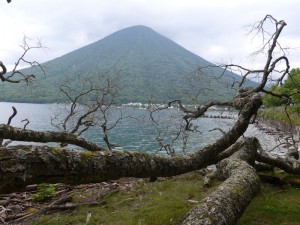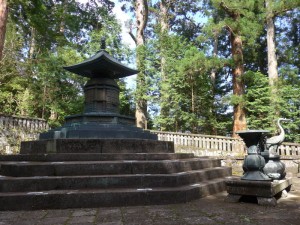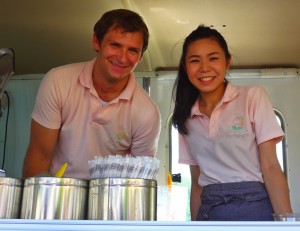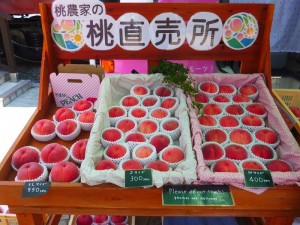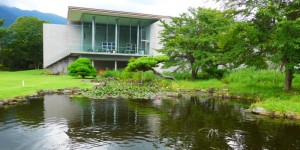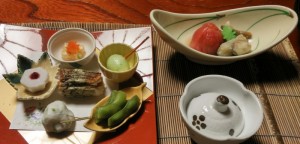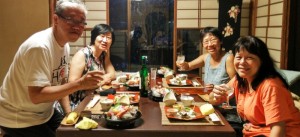Fuji Five Lakes, Hakone-Yumoto & Nikko: August 4 – 9, 2016
August 4 Thursday: Kawaguchiko
The Fuji Five Lakes富士五湖 lie at the northern base of Mt Fuji about 1000m above sea level stretching from Lake Yamanaka 山中湖 from the east to Lake Motosu本栖湖at the western end. Lake Kawaguchi河口湖 is the most famous and accessible by public transportation. Lake Shjiko精進湖 is the smallest one and Saiko Lake西湖shares its banks with the infamous 35-km² Aokigahara Jukai Forest 青木ヶ原.
I got up early and had an hour’s walk along the lake and saw Mt Fuji before the clouds rolled in. We had a sumptuous breakfast in the banquet hall with a peaceful lake-view.
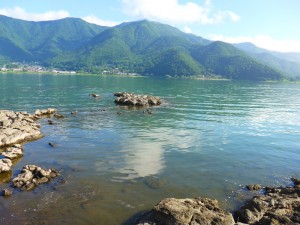 |
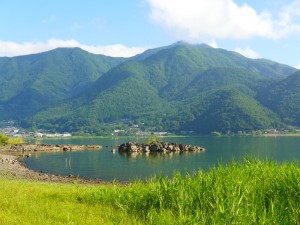 |
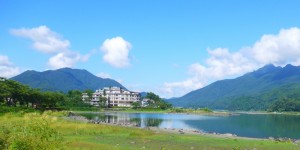 |
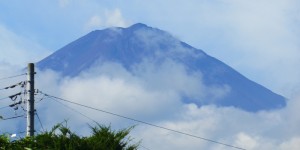 |
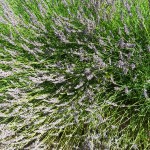 |
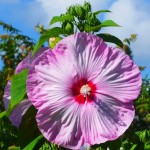 |
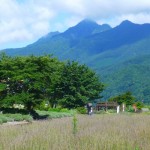 |
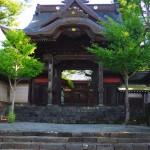 |
We took the free shuttle to the town centre which has a Disney-like railway station. We found a street food car selling fresh peaches and cold drinks. I was thirsty and had a most refreshing peach yogurt drink.
Then we walked towards the lake and strolled along the lake shore. Kai discovered that there would be fireworks at 8pm that evening. It’s a cloudy day and We did not see Mt Fuji. I felt thirsty the whole morning even after having a cold yogurt drink, a beer and a bottle of water. I then realised the cause of my problem – salt and MSG (Mono-sodium-L-Glatamate).
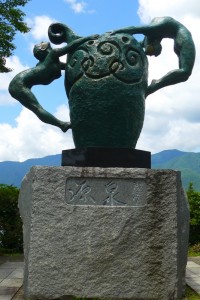 |
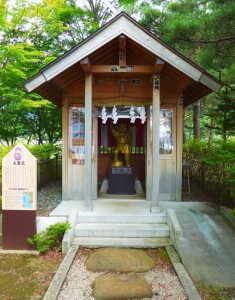 |
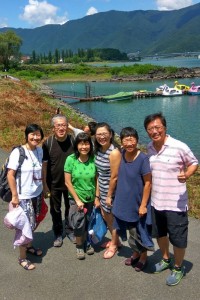 |
We walked all the way to the Kawaguchiko Museum of Art which houses temporary exhibitions and a permanent collection of paintings and photographs featuring Mt Fuji. It was after 2pm when we came out of the museum. We found an interesting restaurant called Alpaca nearby with lovely decorations from South America. The food is delicious and reasonable.
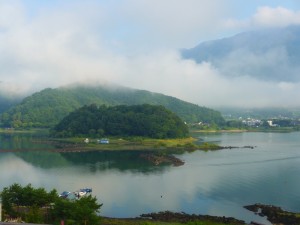 |
Suddenly it rained so heavily that we could not continue our museum tour. There is no direct bus to our hotel. We took a taxi which cost ¥2,000 for three passengers. Fairly expensive! The area is famous for its hot spring. There is an open-air onsen with lake view on the roof top. I had a most enjoyable onsen experience – soaking in hot spring water and in the atmosphere with unearthly beautiful views of the lake and surrounding mountains veiled in mist after the rain.
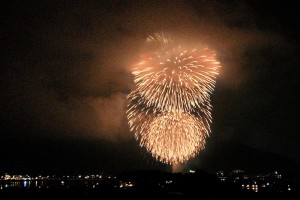 |
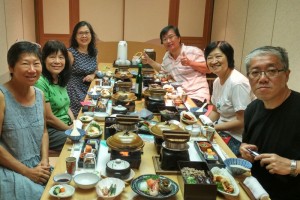 |
We had a sumptuous and delicious seafood dinner in our private dining room. Then we went to watch fireworks on the roof top of the hotel. A wonderful and relaxing day!
August 5 Friday: Kawaguchiko – Hanoke-Yumoto
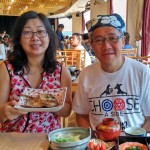 Our hotel is a traditional Japanese-styled hotel. The staff are polite and everything is proper and perfect (though a bit old fashion). The food is excellent. Today, I had half of a red snapper head cooked in sweet sauce for breakfast (again with plenty of MSG!)
Our hotel is a traditional Japanese-styled hotel. The staff are polite and everything is proper and perfect (though a bit old fashion). The food is excellent. Today, I had half of a red snapper head cooked in sweet sauce for breakfast (again with plenty of MSG!)
We ordered a 7-seater minibus from 9:30am to 5pm. I discussed the route with our driver who is professional and knowledgeable about the whole region. There is too much to see in a day. At the end, our driver worked out an interesting route with nine stops.
First stop- Ice Cave. All visitors are required to wear a hamlet as the cave has narrow passages and low ceilings. The temperature inside the cave usually stays below freezing. Hence it has been used since the early 1900s to store ice for use around the year.
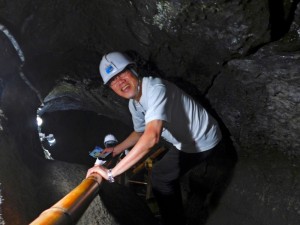 |
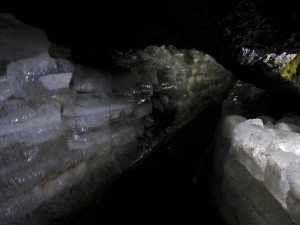 |
Second stop – Aokigahara Jukai Forest (or Sea of Trees). Instead of going to the Wind Cave by car, we decided to follow the trail through the forest which we later found out to be the infamous forest which is known as the Suicide Forest. The wood is so dense that one can disappear without trace. I enjoy the walk and find the forest atmospheric and beautiful.
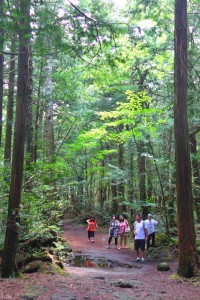 |
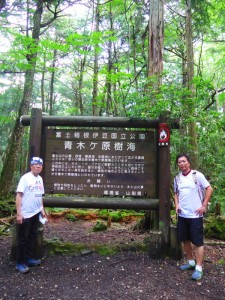 |
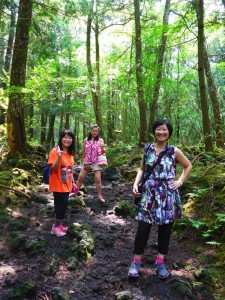 |
Third Stop- Wind Cave. In the past, the cave was used as a natural storehouse and refrigerator: the temperature inside stays at zero degree Celsius throughout the year. There are a few shelves with store boxes of seeds and silkworm cocoons.
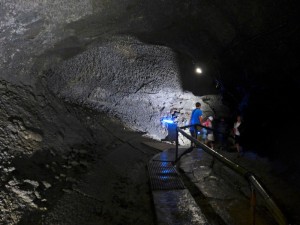 |
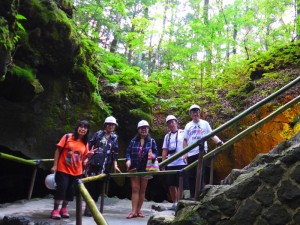 |
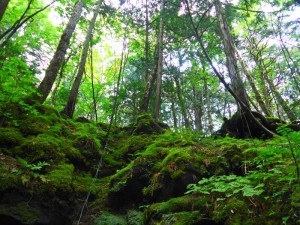 |
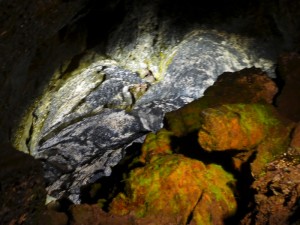 |
Fourth Stop –Lake Shjiko. We just popped out to take a photo in front of the sign board.
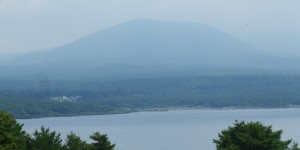 |
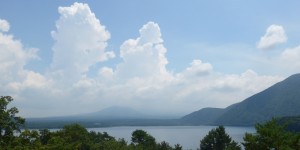 |
Fifth Stop- Lake Motosu, Japan’s ninth deepest lake at 140m. It is featured on the reverse side of the 1,000 yen bill.
Sixth Stop-Lake Saiko. The driver dropped us off at Iyashi no Sato which stands on the site of a former farming village that was destroyed by a landslide during a typhoon in 1966. Today, some 20 traditional thatched roofed houses have been reconstructed and opened as an open air museum and a traditional craft village. The Erosion and Sediment Control Museum explains the causes of the landslide that destroyed the village and techniques used now to prevent such disasters.
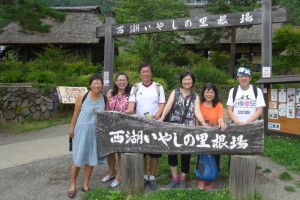 |
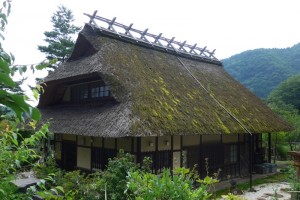 |
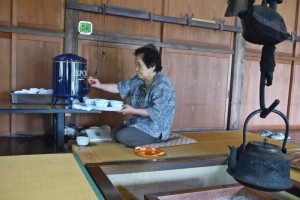 |
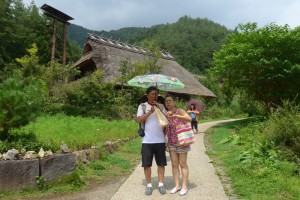 |
Seven Stop – Lunch. The driver took us to a local eatery by Lake Kawaguchi. This area is famous for udon noodles. We had either noodles or set lunch. But the staff were cunning and overcharged us by ¥2,600. Elaine, our Hon Treasurer, discovered the discrepancy and asked for a detailed breakdown. At the end, they handed back ¥3,000 to Elaine. Japanese are honest and it’s the first time ever we come across such a problem in Japan.
Eighth Stop- Fujiyoshida Sengen Shrine 北口本宮冨士浅間神社stands in a dense forest and set off from the main road by a long approach lined with stone lanterns and shaded by tall cedar trees. The shrine’s vermillion buildings include a main hall dating from 1615, a dancing stage and a few auxiliary buildings.
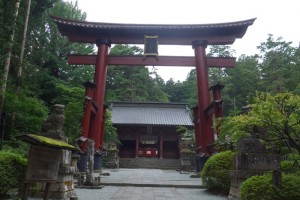 |
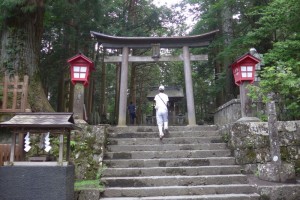 |
The shrine used to be the common starting point for climbing Mt Fuji from the north. The trail head is still located directly behind the right side of the main hall. Some traditional hikers begin their ascent with a prayer at the shrine before passing through the wooden torii gate at the back of the shrine grounds. Nowadays, most hikers start their ascent from Fifth Station of the Fuji Subaru Trail, half way up the mountain at 2305m.
Nineth Stop- Oshino Hakkai忍野八海, a set of eight ponds in Oshino located on a site of a former sixth lake that dried up several hundred years ago. The ponds are fed by snow melt from the slopes of Mt Fuji that filters down the mountain through porous layers of lava for over 80 years resulting in very clear spring water that is revered by the locals. As no entry fee is required, the place is flooded with tourists especially Mainland Chinese tourists on package tour. The stream and spring water are clear and photogenic. Unfortunately, the appeal and the charm of this small World Heritage property has been ruined by the rowdy crowd. What a pity!
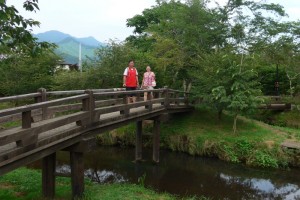 |
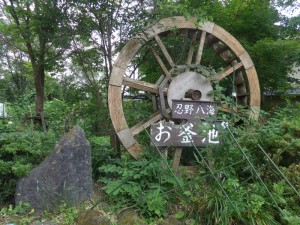 |
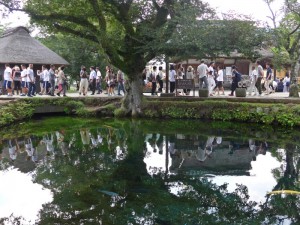 |
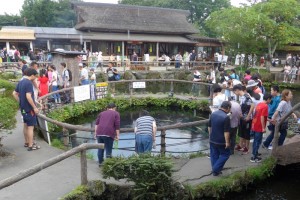 |
We left around 4:15pm and passed by an area which resembles a sea of flowers and then LakeYamanakawithout stopping. Owing to heavy traffic, we took over 75 minutes to reach our hotel Ryoken Senkei about 50km from Oshino. We gave our driver ¥5,000 extra as we had overrun by 30 minutes. He seemed pleased with our small gesture of appreciation.
We paid almost ¥30,000 ppa night for this boutique hotel next to Sukumogawa River. Guests stay in individual houses built around a Japanese garden. Each house has a bedroom (or more), sitting room, toilet and onsen (Japanese bath with hot spring water) and different layout. Guests are served in their own house. We indeed had a most sumptuous dinner: first we had an enormous tray with soup, salad, sashimi, hot-pot with beef followed another tray with a big plate of tempura and a bucket of rice. After dinner, we had dessert.
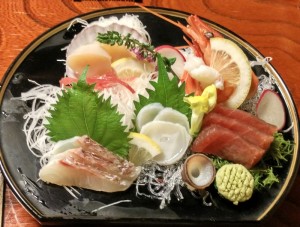 |
|
The lady looking after us is elderly, cheerful but rigid and bossy. I do not care for luxury and would not overspend on accommodation and food. I prefer nature, culture, contacts with locals, interesting experience and authenticity. A clean bed in a safe area and a simple meal with fish and vegetables would do. I loathe to waste food as millions of people are starving. But tonight, I was so full that I did not even touch the tempura and rice. What a shame!
August 6 Saturday: Hakone-Yumoto
As usual, I got up early. Breakfast would be served at 8:30am. Hence, I strolled along the river and found many hotels up the road. Then I crossed the Tamadare Bridge and found a beautiful park where the Tamadare Falls and Tamadare Shrineare located. I would prefer to stay in the hotel next to the park which has an onsen on the roof affording marvellous views of the park and mountains.
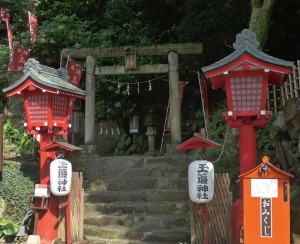 |
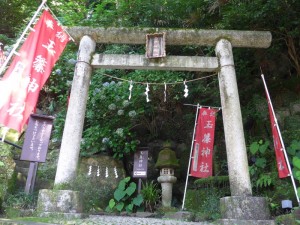 |
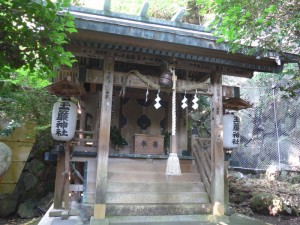 |
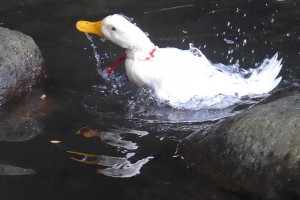 |
After breakfast, Elaine and HM left us for Tokyo as they would return to Hong Kong on August 8. Kai who travels frequently to Japan offered to be the tourist guide for Judia and Donna: they brought a two-day travel Hakone pass for ¥4,000. I had taken a similar tour twice and preferred to spend a quiet day exploring this small onsentown on foot.
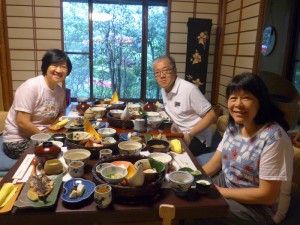 |
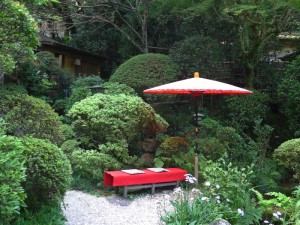 |
I picked up a tourist map from the tourist office and found two walking trails. First, I followed the trail on the right side of the Hayakawa River and stopped at the Shiraishijizo, Amidaji Temple, Fukasawa Benzaiten and Hibuse Kannon.
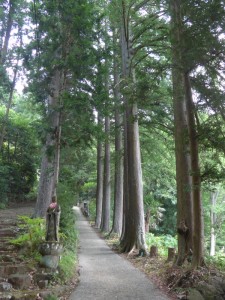 |
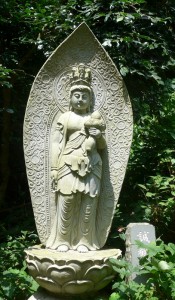 |
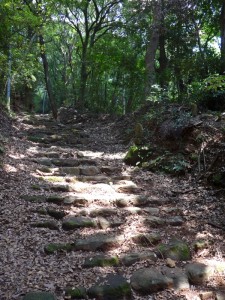 |
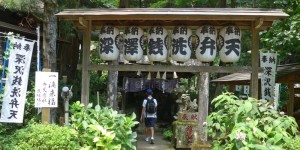 |
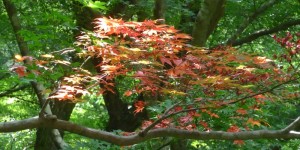 |
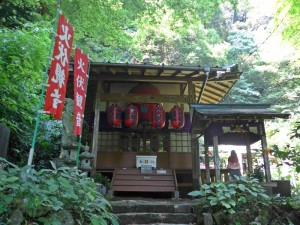 |
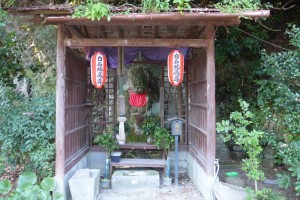 |
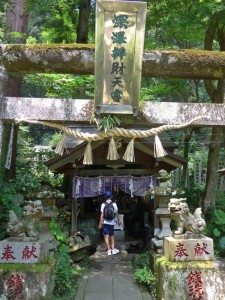 |
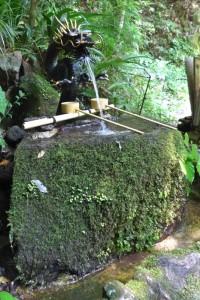 |
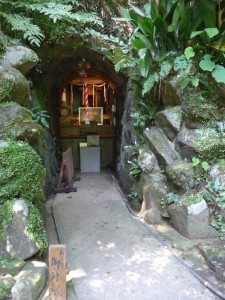 |
The second trail takes me to the other side of the river. I crossed the Ajisai Bridge and walked up a path to a local museum with all display in Japanese. I skipped it and walked towards the Souunji Temple which was closed. After the Hakusan Shrine, I suddenly saw K’s House, a popular and well-run hostel chain. The building looks brand new and modern. I went it and spent over an hour sitting in the spacious and comfortable common room reading travel books. The views of the mountains and the river valley below are fantastic. I prefer staying in a dormitory here for a few thousand yen than squandering ¥30,000 on a luxurious ryoken.
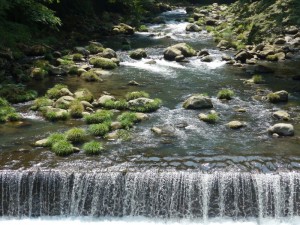 |
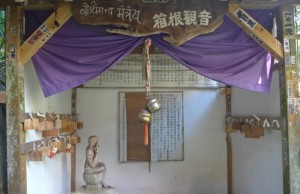 |
I followed the trail and walked along the cobbled stone paved old road. I had some difficulties in finding the Hakone Kannon. I do not know whether I am stupid or it is a problem with the Japanese signage.
The gang of three had a busy and fun day. We met up and had dinner at 7:30pm. Tonight, we had duck which was delicious and light. Though I only had a small bowl of udon noodles for lunch, I still felt too full to finish all the food placed in front of me. The rice was untouched once again.
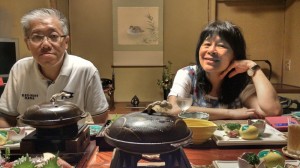 |
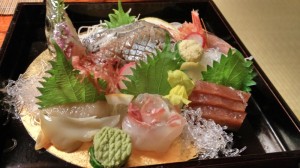 |
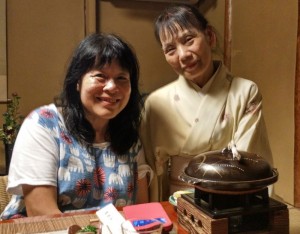 |
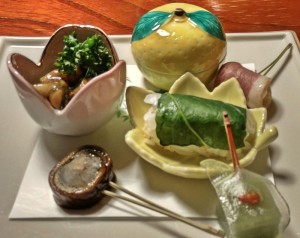 |
August 7 Sunday: Hakone-Yumoto -Nikko
After breakfast, we took a taxi to the JR Odawara station (¥3000). After reserving seats on the 2:45pm Shinkansen train to Tokyo, we stored our luggage (¥500 for a large box). Kai, Judia and Donna used their 2-day pass to return to Hakone. I decided to take a free ride with my JR pass to Atami and Ito. The train goes along the coast which is popular for beach-goers. It was boiling hot-over 30°C and the beaches were packed.
I spent about half an hour in each town before returning to Odarawa. The ride is scenic though I find both towns boring. But I may return to this region on my way to the Izu Peninsula which looks beautiful from the top of Mt Fuji.
The coast is famous for seafood. I had a fish bowl with rice for lunch. My friends arrived just in time for the train. In Tokyo, we took the Tohoku Shinkansen to Otsunomiya where we switched to a local train. By the time we arrived in Nikko, it was 7pm. We took a taxi to Park Mountain Lodge (¥1,000) which is a cozy old house built in western style. The owners are very friendly and speak English. Most of the lodgers are foreigners and backpackers: I felt at home. We had dinner for only ¥1,200. The air is fresh and cool as the house is surrounded by trees. We slept with the windows open and I had an excellent sleep.
August8 Monday: Nikko
![nikko_english_map[1]](http://www.sarahontheroad.hk/wp-content/uploads/2016/08/nikko_english_map1-300x171.gif) I made a day trip to Nikko from Tokyo during my first visit to Japan in the early 1980s. The first buildings were constructed on the slopes of the sacred Nikko mountains by a Buddhist monk in the 8th century. Since then, Nikko has been a sacred site known for its architectural and decorative masterpieces which are closely associated with associated with prominent chapters of Japanese history, especially those relating to the symbolic figure of Shogun Tokugawa Ieyasu (1543-1616).
I made a day trip to Nikko from Tokyo during my first visit to Japan in the early 1980s. The first buildings were constructed on the slopes of the sacred Nikko mountains by a Buddhist monk in the 8th century. Since then, Nikko has been a sacred site known for its architectural and decorative masterpieces which are closely associated with associated with prominent chapters of Japanese history, especially those relating to the symbolic figure of Shogun Tokugawa Ieyasu (1543-1616).
I am captivated by its serene natural setting, landscape, temples and shrines and always want to return. In 1999, two Shinto shrines (The Toshogu and The Futarasan-jinja) and one Buddhist temple (The Rinno-ji) comprising 103 religious buildings many of which were constructed in the 17th century, together with their natural surroundings with a total area of 50.8-hectare were inscribed on the World Heritage List.
As we had two days in Nikko, we brought a 2-day bus pass for ¥3,000. We would spend the first day hiking in Okunikko, a region known for its majestic nature with 11 mountains over 2000m, rivers, three famous waterfalls (Kegon, Yudaki and Ryuzu Falls), lakes, wetland and swamps. There are ten hiking trails graded Beginner, Moderate or Advanced. The shortest one takes an hour while the longest Mt Shirane climbing trail would take over eight and a half hours. Japanese are perfectionists who are creative, aesthetic and meticulous. It is not surprising that the hiking trails here are well-designed and maintained with a boardwalk built in harmony with the lush natural setting. The signage is excellent. We started around 11am at the Yumoto Onsen bus terminal (1,650m) and followed the 6.3km-longSenjogahara Moor Nature Research Trail (6.3km) to Ryuzu Falls
First, we walked next to the Lake Yunoko which is tranquil and deserted. We had an easy downhill stroll to the Yudaki Falls.
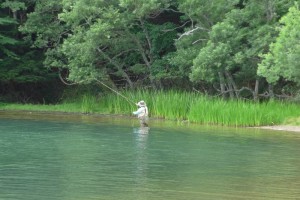 |
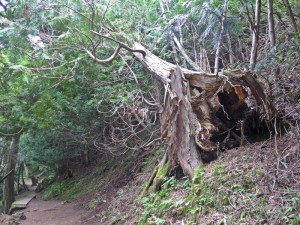 |
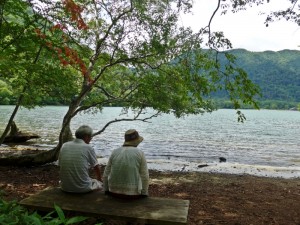 |
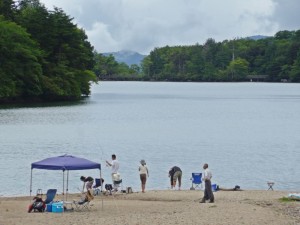 |
Then we had lunch by the base of the falls. The area is famous for trout from the lake. The locals grill it with salt (¥500 each). It is most delicious and I had two. I also tasted the sweet red-bean cake.
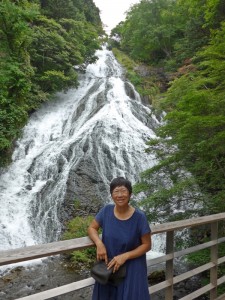 |
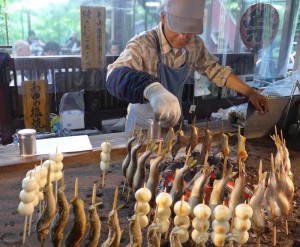 |
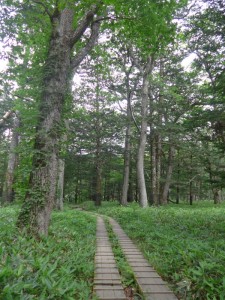 |
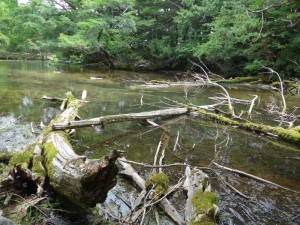 |
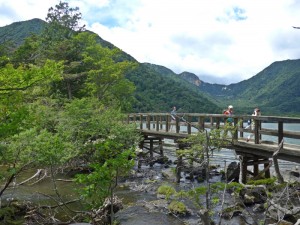 |
Following the Yugawa River, we soon arrived at the Senjogahara Moor, an expansive wetland at an elevation of about 1400m with Mt Nantai (2846m), the highest mountain in Nikko as the backdrop.
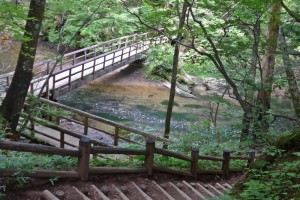 |
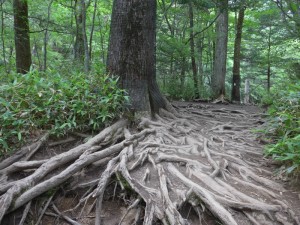 |
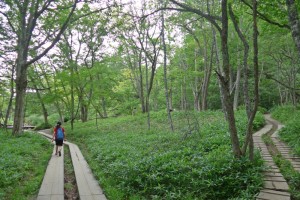 |
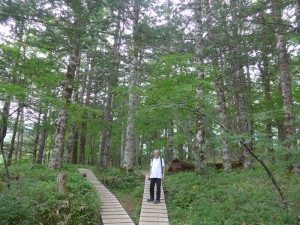 |
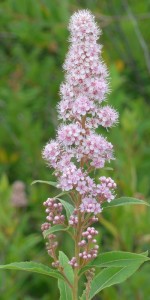 |
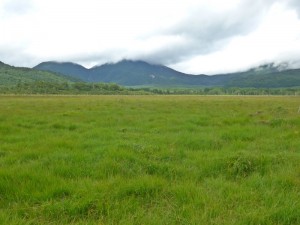 |
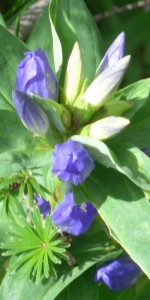 |
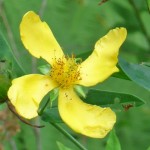 |
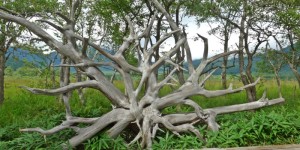 |
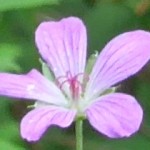 |
Finally we reached the Ryuzu Falls close to Lake Chuzenji, a lava-dammed lake 1269m above sea levelthat was formed when Mt Nantai erupted about 20,000 years ago. The name “ryuzu” meaning “dragon’s head” came from the large rock at the basin splitting the water into two streams. Water flows quickly over its 210 metre-long step-like rock face. The falls are stunning in spring with azaleas and in autumn for the foliage colours.
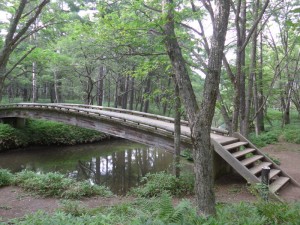 |
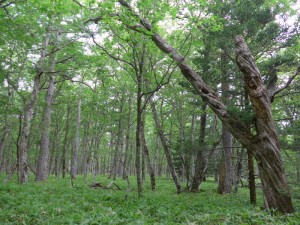 |
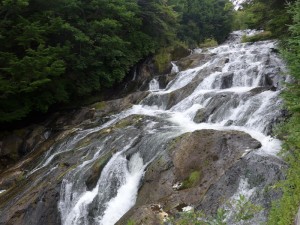 |
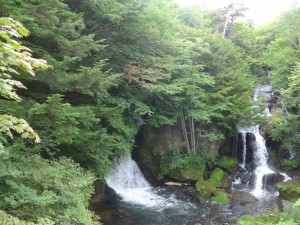 |
It was about 4pm and we took the bus back to Nikko. Tired and hungry, we had an early dinner around 6pm. Donna insisted in treating us: we had a delicious dinner in a fast-food chain restaurant. Good food and great value!
August 9 Tuesday: Nikko – Karuizawa
Judia, Donna and Kai decided to spend the last three nights in Tokyo. I prefer the countryside and small towns. I said good-bye to the Gang of Three after breakfast. First, I took a bus to Lake Chuzenji. It was early and very quiet. I walked along the lake to the Chuzen-ji Temple 中禅寺(¥550). The temple was built around an unique 6m-tall statute of Kannon which was carved out of a tree trunk that still stands today with its roots in the ground.
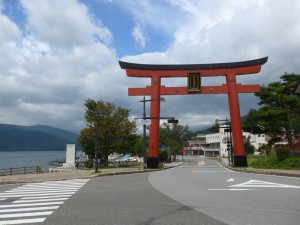 |
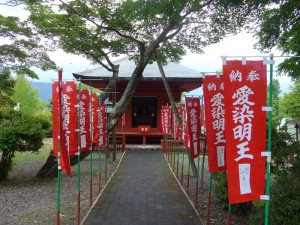 |
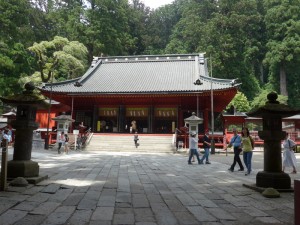 |
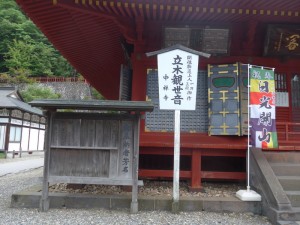 |
At 11am, I had a bowl of udon noodles (¥700). Then I walked to the Kegon Falls, Japan’s highest waterfall at 97m. I am not impressed and find the two waterfalls I visited the day before more picturesque and beautiful. I took the bus back to Nikko and spent the afternoon visiting the three World Heritage Properties. The whole area built on the hill side is compact and interlinked with wide avenues lined with cypress and pine trees.
First I went to the small Futarasan-jinja Shrine (¥200) which was founded in 782 by Shodo Shonin, the Buddhist monk who introduced Buddhism to Nikko and founded the Ronnoji Temple. It is dedicated to the deities of Nikko’s three most sacred mountains namely Mount Nantai, Mount Nyoho and Mount Taro.
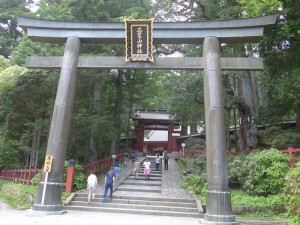 |
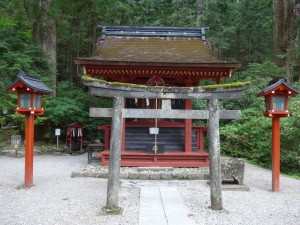 |
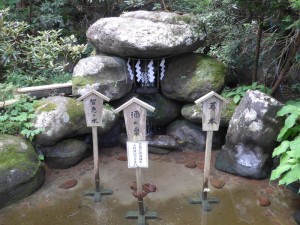 |
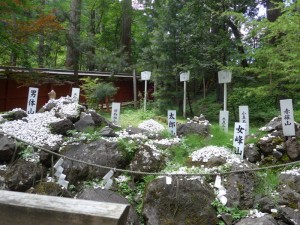 |
My second stop was Taiyuinbyo 大猷院廟, the mausoleum of the third Tokugawa Shogun Iemitsu and grandson of Ieyasu (¥550). This lavish mausoleum complex located next to the Futarasan-jinja Shrine, resembles the nearby Toshogu Shrine in layout and architecture. It is a sub temple of the Rinnoji Temple.
The Niomon Gate, the entrance to Taiyuinbyo is under renovation. Close to the gate is the atmospheric Bakedoro (haunted garden lantern laid out in the shape of the earthly world).
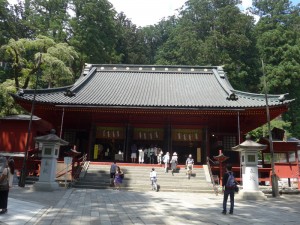 |
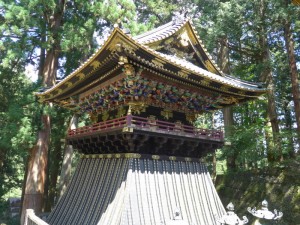 |
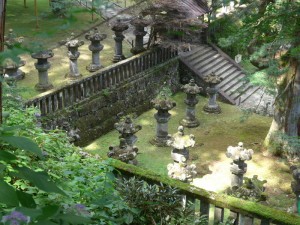 |
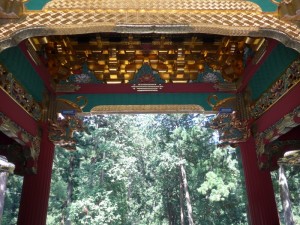 |
After passing the beautiful drum and bell towers which were lit up by the sun, I entered the even more lavishly decorated Nitenmon Gate. Then I arrived at the Karamon Gate in front of the Haiden (the praying hall) with exquisite interior decorated with precious ornaments, an elegant coffered ceiling, beautiful carving and gold lacquered pillars and walls. Finally I reached the Honden (the main hall). I strolled along the corridor and saw the staircase leading up to Iemitsu’s temple-like mausoleum.
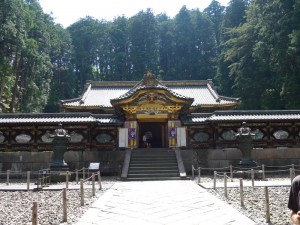 |
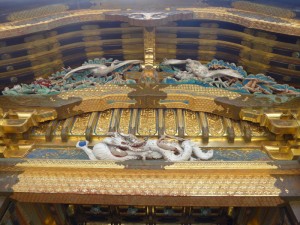 |
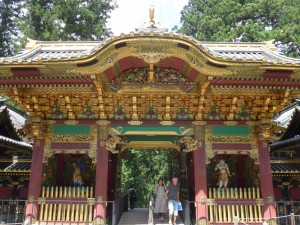 |
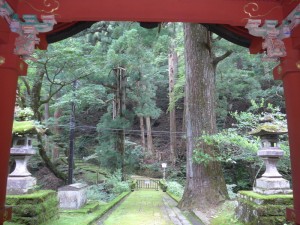 |
When walking along a beautiful wide avenue towards the Toshogu Shrine, I caught sight of the Gang of Three. What a coincidence! I brought a combined ticket for the shrine and the Toshogu Art Museum for ¥1,300.
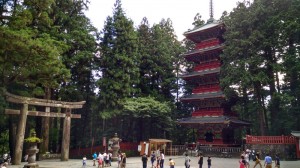 The shrine features a mix of Buddhist and Shinto structures. It was common for places of worship to contain elements of both religions until the Meiji Period when Shinto was deliberately separated from Buddhism. The shrine was where the first shogun Ieyasu Tokugawa (ruling from 1603 to 1605) is enshrined. As many as 127,000 craftsmen were involved in constructing the shrine, using the highest level of technology available at the time.
The shrine features a mix of Buddhist and Shinto structures. It was common for places of worship to contain elements of both religions until the Meiji Period when Shinto was deliberately separated from Buddhism. The shrine was where the first shogun Ieyasu Tokugawa (ruling from 1603 to 1605) is enshrined. As many as 127,000 craftsmen were involved in constructing the shrine, using the highest level of technology available at the time.
The Shrine is studded with architectural gems: a five-story Pagoda at the entrance, three sacred warehouses, a bell tower, a drum tower, the Yomeimon Gate decorated with brilliant colours and over 500 sculptures, the Karamon Gate which is under restoration till 2020 and the Hall of Crying Dragon. In the Shinkyusah (sacred stable) for the horses serving God, there is a series of eight carved boards on which the life of a monkey is illustrated. Many visitors take picture of the ‘Three Monkeys” in the “see no evil, hear no evil and speak no evil’ poses. I walked through the gate with the famous ‘Sleeping Cat’ created by Hidari Jingoro and climbed up a long flight of steps. At the top of the hill is the Inner Shrine where Tokugawa Ieyasus Tomb stands. The story behind the carving is that the cat would ward off mice.
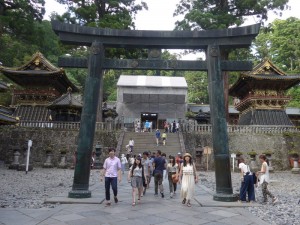 |
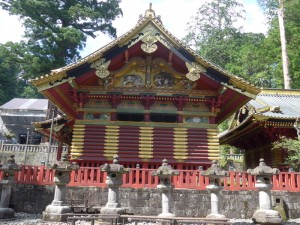 |
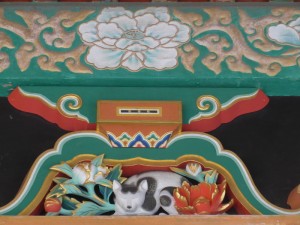 |
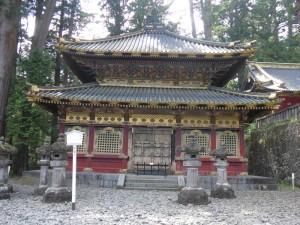 |
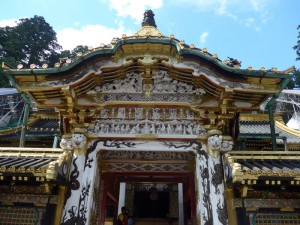 |
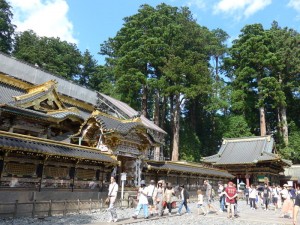 |
I took a look of the Okariden Hall which is closed for visitors before arriving at the new Toshogu Art Museum. Of course the exhibits are all about the Tokugawa era. I watched a film on the life of Tokugawa Ieyasu who was portrayed as learned, open and progressive for his time and a great strategist and leader.
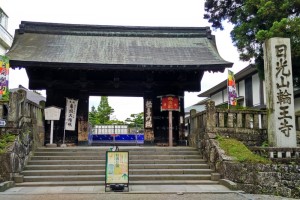 |
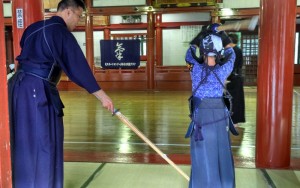 |
My final stop was the Rinnoji Temple where three gilded wooden Buddha statues, 8.5m-high each are enshrined in the main hall. It is one of the temples representing the Tendai School of Buddhism along with Hieizan Enryakuji in Otsu City and Kaneiji in Tokyo. The entrance fee is ¥400. The entire building is wrapped up for renovation. I was disappointed as there is not much to see.
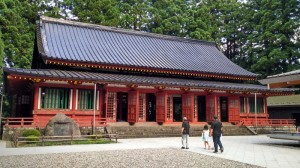 |
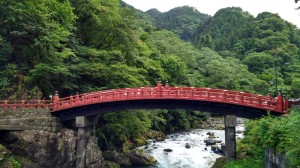 |
On my way to the railway station, I saw the iconic arch-shaped vermillion Shinkyo Bridge over the Daiyagawa River from a distance. I arrived in the station just in time for the 5:12pm train. My original plan was to visit Hiraizumi, a World Heritage Site with temples, gardens and archaeological sites relating to the Pure Land Buddhism about 350km northeast of Nikko. When I arrived at the Utsunomiya station, I discovered I was not entitled to take the shinkansen to Hiraizumi with my East Japan pass.
Where to go? My pass is valid on the Tohoku Shinkansen that goes to Karuizawa軽井沢, a popular mountain resort often featured in Japanese TV and literature. So I took a shinkansen from Utsunomiya to Omiya and then Karuizawa. I arrived at the modern Karuizawa railway station before 8pm.
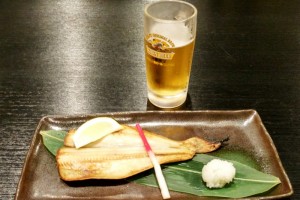 Where to stay? Next to the train station is an APA Hotel. I went there only to find out it was full. The receptionist suggested me go to Prince Resort on the other side of the railway station. But the room rate showed in Booking.com was over US$400. So if I could not find a room, I would either return to Tokyo or find another city along the shinkansen line. I did not need to pay for the train ride anyway.
Where to stay? Next to the train station is an APA Hotel. I went there only to find out it was full. The receptionist suggested me go to Prince Resort on the other side of the railway station. But the room rate showed in Booking.com was over US$400. So if I could not find a room, I would either return to Tokyo or find another city along the shinkansen line. I did not need to pay for the train ride anyway.
Then I spotted a bar restaurant next to the train station and hope to find some information on home-stay and hostels. The chef speaks English and is most helpful. He called Route-inn in Miyota which had the last room for ¥7,500. I jumped with joy. The chef even walked me to the station to take a local train (¥310). The ride took less than 30 minutes. I took a taxi (¥700) to the hotel. The young receptionist is most helpful. I ended up spending two nights there. I had dinner with a beer just before the restaurant closed at 9:30pm. I was lucky!


